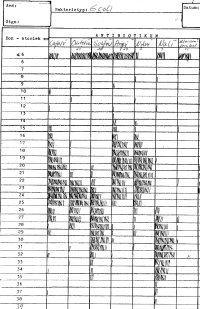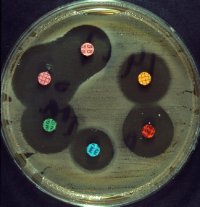|
Historical aspects and the concept of species-related interpretive
zone diameter breakpoints
Antimicrobial susceptibility testing in the clinical laboratory
is most often performed using the disc diffusion method. This method
was originally standardized by Bauer
et al. (the so called Kirby-Bauer method), and by Ericsson
& Sherris.
A well-known authority on antimicrobial susceptibility testing,
Dr Ronald Jones, USA, wrote: " ... the disk diffusion test continues
to be the most versatile, broadly accurate, and reproducible AST
test we can use in the clinical microbiology laboratory." [Jones,
R.N. 1992. Clinical Microbiology Newsletter 14:33-37]
The Ericsson & Sherris method was adopted early as the method
of choice for susceptibility testing in Sweden, but in those days
the susceptibility categories were called 1, 2, 3, and 4. In 1978
this was changed by the Swedish reference group to the more international
S, I, and R categories.
In 1976 we had started to plot zone diameter histograms species-wise
for the different antibiotics in Lund. This revealed homogeneous
populations of isolates representing wild type susceptible isolates
as well as strains with various degrees of resistance. The new zone
breakpoints from SRGA in 1978 did not always fit individual species
so exceptions with special breakpoints were introduced locally in
Lund. We concluded that a proper asignment of a susceptibility category
of an isolate as S, susceptible, I, intermediate susceptible, or
R, resistant, to a given antibiotic required knowledge about the
distribution of zone diameters for that combination of bacterial
species and antibiotic. The concept of species-related
interpretive zone breakpoints for SIR categorization was introduced.
The basic rule is that an interpretive zone breakpoint should never
cut a homogeneous population of isolates in a zone histogram for
a given combination of bacterial species and antibiotic, be it a
fully susceptible population or one with decreased susceptibility.
Comparative quality control studies in the 1980:ies were performed
by the Lund team involving all laboratories in Sweden. In two of
the studies, Gunnar Kahlmeter, then a young doctor in the lab, was
a team member. All these studies showed very clearly that there
were interpretive problems using general breakpoints. The Swedish
Reference Group for Antibiotics, SRGA, then appointed Gunnar Kahlmeter
in 1986 to chair a methodology subgroup to further analyze the experiences
gained in Lund and to produce experimental material from several
other laboratories to test the concept of species-related interpretive
breakpoints, a concept which was later adopted as a national
standard in Sweden. For full details of the SRGA standard, interpretive
breakpoints, populations of isolates with both MIC and zone diameter
distributions, and other valuable information FREE
OF CHARGE, both in English and in Swedish, see the
SRGA home page.
Species-specific interpretation was not new, but had earlier only
been suggested for occasional combinations of species and antibiotics,
e.g.
carbenicillin and P.aeruginosa in 1974 and
chloramphenicol and P.mirabilis in 1980. Our extensive histogram
studies of the years showed the need for a more general concept
of species-related interpretive breakpoints. It should also be mentioned
that Thomas
F. O'Brien had pioneered studies of zone diameter histograms
already in the 1960:ies.
All histogram studies so far had used simple visual inspection with
comparison of interpretive breakpoints to evaluate possible problems.
We felt the need for a more objective method to analyze histograms
species-wise and then came up with "single-strain regression analysis"
to produce species-specific regression lines,
(see next page).
NEXT 
|

